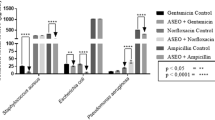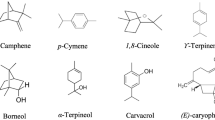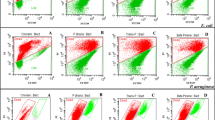Abstract
The growth-inhibiting activities of the essential oils extracted from Platycladus orientalis leaves and stems were examined against intestinal bacteria. The leaf oil exhibited a strong response against Clostridium difficile and C. perfringens at 5.0 mg/disc, but the stem oil showed no inhibitory activity against intestinal bacteria. The oils from P. orientalis leaves and stems were analyzed by GC-Mass spectroscopy. The main constituents of the essential oil in P. orientalis leaves: α-pinene (18.5%), cedrene (13.6%), α-cedrol (11.3%), β-caryophyllene (10.2%), 3-carene (8.2%), and α-terpinyl acetate (5.1%), and in the stems: α-pinene (17.7%), 3-carene (16.3%), β-caryophyllene (13.4%), β-phellandrene (9.5%), β-selinene (6.5%), and α-cedrol (6.1%). The cedrene isomers showed significant (33.1–34.7 mm) inhibitory effect against C. difficile and C. perfringens and moderate inhibitory effect against Escherichia coli at 2.0 mg/disc. The oil of P. orientalis leaves, in which cedrene isomers are the major component, could be used as a selective inhibitor against harmful bacteria.
Similar content being viewed by others
References
Guarner F, Malagelada JR. Gut flora in health and disease. Lancet 361: 512–519 (2003)
Conte MP, Schippa S, Zamboni I, Penta M, Chiarini F, Seganti L, Osborrn J, Falconieri P, Borrelli O, Cucchiara S. Gut-associated bacterial microbiota in paediatric patients with inflammatory bowel disease. Gut 55: 1760–1767 (2006)
Nord CE, Rasmanis G, Wahlund E. Effect of dalbavancin on the normal intestinal microflora. J. Antimicrob. Chemoth. 58: 627–631 (2006)
Beaugerie L, Petit JC. Antibiotic-associated diarrhea. Best Pract. Res. Cl. Ga. 18: 337–352 (2004)
Kim MG, Lee HS. Growth-inhibiting activities of phenethyl isothiocyante and its derivatives against intestinal bacteria. J. Food Sci. 74: M467–471 (2009)
Jeong EY, Jeon JH, Kim HW, Kim MG, Lee HS. Antimicrobial activity of leptospermone and its derivatives against human intestinal bacteria. Food Chem. 115: 1401–1404 (2009)
Lee HS, Ahn YJ. Growth-inhibiting effects of Cinnamomum cassia bark-derived materials on human intestinal bacteria. J. Agr. Food Chem. 46: 8–12 (1998)
Choi JW, Cho EJ, Lee DG, Choi K, Ku JJ, Park KW, Lee HS. Antibacterial activity of triterpenoids from Clerodendron trichotomum. J. Appl. Biol. Chem. 55: 169–172 (2012)
Lee YJ, Hwang SM, Yoon JJ, Lee SM, Kyung EH, Kim JS, Kang DG, Lee HS. Inhibitory effect of Thuja orientalis on TNF-α-induced vascular inflammation. Phytother. Res. 24: 1489–1495 (2010)
Lee HS. Tyrosinase inbibitors of Pulsatilla cernua root-derived materials. J. Agr. Food Chem. 50: 1400–1403 (2002)
Lee HS. Acaricidal activity of constituents identified in Foeniculum vulgare fruit oil against Dermatophagoides spp. (Acari: Pytoglyphidae). J. Agr. Food Chem. 52: 2887–2889 (2004)
Lei H, Wang Y, Liang F, Su W, Feng Y, Guo X, Wang N. Composition and variability of essential oils of Platycladus orientalis growing in China. Biochem. Syst. Ecol. 38: 1000–1006 (2010)
Guleria S, Kumar A, Tiku AK. Chemical composition and fungitoxic activity of essential oil of Thuja orientalis L. grown in the north-western Himalaya. Z. Naturforsch. C 63: 211–214 (2008)
Jeon JH, Lee SH, Kim MK, Lee HS. Larvicidal activity of Chamaecyparis obtuse and Thuja orientalis leaf oils against two mosquito species. J. Korean Soc. Appl. Biol. Chem. 48: 26–28 (2005)
Yang JY, Cho KS, Chung NH, Kim CH, Suh JW, Lee HS. Constituents of volatile compounds derived from Melaleuca alternifolia leaf oil and acaricidal toxicities against house dust mites. J. Korean Soc. Appl. Biol. Chem. 56: 91–94 (2013)
Zhou Z, Liu X, Yang F, Wang L. Comparison of chemical composition of essential oil from Platycladus orientalis by supercritical fluid extraction and steam distillation extraction. Med. Eng. Bioinform. 19: 219–224 (2014)
Hashemi SM, Safavi SA. Chemical constituents and toxicity of essential oils of oriental arborvitae, Platycladus orientalis (L.) Franco, against three stored-product beetles. Chil. J. Agr. Res. 72: 188–194 (2012)
Afsharypuor S, Nayebzadeh B. Essential oil constituents of young stem, leaf and fruit of Platycladus orientalis (L.) Franco grown in Isfahan (Iran). J. Essent. Oil Res. 21: 525–528 (2009)
Valentines MC, Vilaplana R, Torres R, Usall J, Larrigaudiere C. Specific roles of enzymatic browning and lignification in apple disease resistance. Postharvest Biol. Tec. 36: 227–234 (2005)
Hassanzadeh MK, Rahimizadeh M, Bazzaz BSF, Emami SA, Assili J. Chemical and antimicrobial studies of Platycladus orientalis essential oils. Pharm Biol. 39: 388–390 (2001)
Ngan LTM, Moon JK, Kim JH, Shibamoto T, Ahn YJ. Growth-inhibiting effects of Paeonia lactiflora root steam distillate constituents and structurally related compounds on human intestinal bacteria. World J. Microb. Biot. 28: 1575–1583 (2012)
Carson CF, Hammer KA, Riley TV. Melaleuca alternifolia (Tea tree) oil: A review of antimicrobial and other medicinal properties. Clin. Microbiol. Rev. 19: 50–62 (2006)
Asili J, Rard MR, Ahi A, Emami SA. Chemical composition of the essential oil from aerial parts of Haplophyllum acutifolium (DC.) G. Don from Iran. J. Essent. Oil Bear Pl. 14: 201–207 (2011)
Kim MK, Kim YM, Lee HS. Growth-inhibiting effects of Juniperus virginiana leaf-extracted components toward human intestinal bacteria. Food Sci. Biotechnol. 14: 164–167 (2005)
Murugesan S, Rajeshkannan C, Sumathi R, Manivachakam P, Babu DS. Bioactivity of root hexane extract of Coleus forskohlii Briq. Laviatae: GC/MS/MS characterization and identification. Eur. J. Exp. Biol. 2: 1469–1473 (2012)
Sankahya NB, Kayce P, Halay E, Göktürk RS, Sümbül H, Kirmizigül S. Phytochemical analysis of the essential oils of 10 endemic Cephalaria species from Turkey. Nat. Prod. Res. 27: 830–833 (2013)
Su YC, Hsu KP, Wang EI, Ho CL. Composition, anticancer, and antimicrobial activities in vitro of the heartwood essential oil of Cunninghamia lanceolata var. konishii from Taiwan. Nat. Prod. Commun. 7: 1245–1247 (2012)
Mastelic J, Politeo O, Jerkovic I, Radosevic N. Composition and antimicrobial activity of Helichrysum italicum essential oil and its terpene and terpenoid fractions. Chem. Nat. Compd. 41: 35–40 (2005)
Nibret E, Wink M. Trypanocidal and antileukaemic effects of the essential oils of Hagenia abyssinica, Leonotis ocymifolia, Moringa stenopetala, and their main individual constituents. Phytomedicine 17: 911–920 (2010)
Author information
Authors and Affiliations
Corresponding author
Rights and permissions
About this article
Cite this article
Kim, MG., Lee, HS. Growth-inhibiting effects and chemical composition of essential oils extracted from Platycladus orientalis leaves and stems toward human intestinal bacteria. Food Sci Biotechnol 24, 427–431 (2015). https://doi.org/10.1007/s10068-015-0056-5
Received:
Revised:
Accepted:
Published:
Issue Date:
DOI: https://doi.org/10.1007/s10068-015-0056-5




